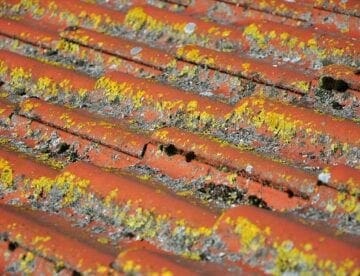Pitched roof styles are some of the most popular types of roofing construction in the US. Why? Because a pitched roof’s shingles are installed in an overlapping fashion, which helps shed water. Also, a pitched roof can be designed in a wide variety of styles to fit nearly any aesthetic tastes. While pitched roofs may have many advantages for resisting water ingress and wind damage, they do have a few downsides. So, what are the pros and cons of a pitched roof versus a flat roof? Let’s explore.
Pitched Roof vs. Flat Roof Major Differences
The major differences between a pitched roof and a flat roof are appearances and the way in which these different roofing systems are constructed. A pitched roof can come in a range of styles, such as hipped, gambrel, and mansard designs. Either way, a pitched roof will have a variety of angles to help shed water and snow unlike a flat roof.
Flat roofs, on the other hand, have no angles as the name implies. Flat roofs may have a built-up, single ply, or sprayed polyurethane foam construction. Below is a list of the pros and cons of either a flat roof or pitched roof.
Pitched Roof Pros
When choosing the right style of roof for your building, consulting with an experienced roofing contractor is key. With their assistance, you’ll be able to explore the right kind of roof style for your property. Flat and pitched roofs differ not only in appearance, but also in price, maintenance and water shedding. The pros of a pitched roof include:
- Traditional styles — Pitched roofs offer property owners a range of traditional building styles to choose from. No matter what your aesthetic tastes and goals for your home or commercial property, chances are, a certain pitched roof style will meet them.
- Efficiency in water shedding — Roofs with sufficient angles are best for evacuating water. Pooling water on the roof can lead to a range of issues, including leaks, and algae and moss growth.
- Easier to maintain — Slopes on a pitched roof will easily shed dirt, debris, and leaves. Debris left to rot on a roof will damage the structure over time and will also clog the gutters.
Pitched Roof Cons
Pitched roofs may look aesthetically pleasing and do an excellent job of water evacuation. But, they do have a few downsides.
- Costs — Constructing a pitched roof will cost more upfront than a flat roof. Repairing a pitched roof will also cost more than a flat roof because the angles and slopes pose unique risks to contractors. It is often more labor intensive to repair a pitched roof with varying angles and slopes than a flat roof.
- Harder to construct — Complex architecture can make it more problematic and difficult to cap the building with a pitched roof design. A pitched roof requires a complicated rafter system to be installed. In buildings that have a complex design, a pitched roof may not be possible or may be too cost-prohibitive to have installed.
- Difficult to inspect — While the angles and slopes of a pitched roof may keep dirt and debris from gathering on the shingles, it does make it more difficult for the average homeowner to inspect the roof for any potential problems and leaks.
Flat Roof Pros
In places that experience a lot of heavy rain and moisture like the Tampa Bay area, flat roofs may seem like a poor choice of construction. But flat roofs do have several advantages that can make them suitable for wet and rainy climates. If you choose a flat roof for your building, hiring an experienced roofing contractor for the project will ensure durable and adequate construction in a flat roof design—despite the weather patterns.
The main pro or advantage of having a flat roof put on your building is the cost of the installation. Many Florida homeowners who need a new roof installed may find the upfront costs of pitched roofs prohibitive. Fortunately, having a flat roof constructed instead may fit within the budget. The upfront costs of a flat roof tend to be much cheaper than a pitched roof by thousands of dollars. Flat roofs can be installed on nearly any architectural design, too, unlike a pitched roof.
Flat Roof Cons
It’s true that you may pay less upfront for a flat roof. The downside is that these styles of roofs don’t shed water as easily as a pitched or sloped roof. Nor do they shed debris, such as sticks and leaves, as quickly as a pitched roof. As such, debris and water can easily collect on the roof.
When this occurs, gutters can become clogged, and the waterproof seal in the roofing system can fail. Moss and algae can also proliferate. Over the lifespan of a flat roof, homeowners may find themselves shelling out more money in maintenance and repair costs than if they’d had a pitched roof installed.
Avoiding Maintenance and Repair Issues with Flat Roofs
It’s possible to protect the structure of a flat roof from debris and water ingress with certain installation and construction techniques. EPDM roofing is the most common type of water-resistant membrane used in flat roof construction. Single-ply roofing is also common.
EPDM materials for flat roofs are made out of recycled rubber, making this type of flat roof environmentally-friendly. Also, EPDM is an incredibly water-resistant material, and can last between 30 and 50 years before you’d need a new roof installed. Having EPDM installed for a flat roof design will make the building resistant to heavy rain, wind, and fire damage, too.
Another material that can be used to make a durable and long-lasting flat roof is modified bitumen. This material is comprised of reinforced polymer cap sheets or layers to create a durable roofing system. Constructing a flat roof out of strong materials will help property owners avoid some of the common issues found in flat roofs.
Flat Roofs vs. Pitched Roofs: A Takeaway Message
Several things will factor into your final choice for either a flat roof or pitched roof for your building. How much you can afford to spend upfront, your building’s architecture, and your aesthetic tastes will all play a role in this decision. If you’re looking to have a new roof installed in the Tampa Bay area, contact us today for a free, no-obligation consultation.



